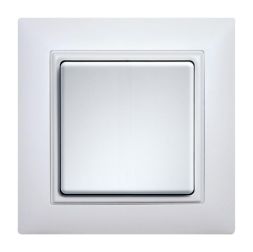2 normally open contacts, potential-free 16A/250V AC, 230V LED lamps up to 200W, incandescent lamps 2000W. Standby loss only 0.03-0.4 watts. Priorities of the central control can be selected. Modular device for mounting on DIN-EN 60715 TH35 mounting rail. 1 division unit = 18mm wide, 58mm deep. State-of-the-art hybrid technology combines the advantages of wear-free electronic control with the high performance of special relays. Local universal control voltage 8..230V UC. With additional control inputs central on and central off for 8..230V UC, galvanically isolated from the local control input. Supply voltage as the local control voltage. Very low switching noise. Glow lamp current from 110V control voltage up to 50mA in switch positions 1 to 3 and 5 to 7. By using a bistable relay, there is no coil power loss and no heating as a result, even when switched on. After installation, wait for the short automatic synchronization before connecting the switched consumer to the mains. Maximum current as a sum across both contacts 16A at 230V. With control LED. This flashes after 15 seconds if the local button is blocked, not in rotary switch positions 4 and 8. Using the upper rotary switch, this impulse switch can be fully or partially excluded from the central control: ZE+ZA = Central on and central off are effective, whereby a response delay of 0, 1, 2 or 3 seconds can be selected for central on. ZE = Only central on is effective, whereby a response delay of 0, 1, 2 or 3 seconds can be selected. ZA = Only central off is effective. ZE+ZA crossed out = No central control is active. Different priorities can be set using the lower rotary switch. These specify which other control inputs are blocked as long as a control input is continuously energized. This also decides how the ES12Z impulse switch should behave when the supply voltage fails and returns: In switch positions 1 to 4 the switch position remains unchanged in the event of a failure, in switch positions 5 to 8 it is switched off. Pending central commands are executed immediately when the power returns. OFF = Permanently OFF, ON = Permanently ON. 1 and 5 = No priority. Local keying is also possible when the central control inputs are permanently energized. The last central command is executed. This is the factory setting. 2 and 6 = Priority for central on and off. Local keying has no effect as long as this. However, permanent excitation central off takes priority over permanent excitation central on. 3 and 7 = Priority for central on and off. Local keying has no effect as long as this. However, permanent excitation centrally on has priority over permanent excitation centrally off. 4 and 8 = priority for permanently excited local buttons. Central commands are not executed until then. A glow lamp current is not permitted in these positions.
| Property | Value |
| Width in modular spacing: | 1 |
| Rated switching current: | 16 A |
| Control voltage 1: | 230 to 8 V |
| Control voltage type 1: | AC/DC |
| Control voltage 2: | 8 to 230 V |
| Installation depth: | 58 mm |
| Function: | electronic switch |
| Mounting type: | DIN rail |
| Frequency of control voltage 1: | 50 Hz |
| Frequency of control voltage 2: | 50 Hz |
| Type of supply voltage: | AC |
| Supply voltage: | 250 V |
| Max. incandescent lamp load: | 2000 W |
| Max. Fluorescent lamp load: | 1000 VA |
| Max. fluorescent lamp load (duo circuit): | 1000 VA |
| Max. fluorescent lamp load (parallel compensated): | 500 VA |
| Max. switching current (cos phi = 0.6): | 4 A |
| Number of contacts as normally open: | 2 |








